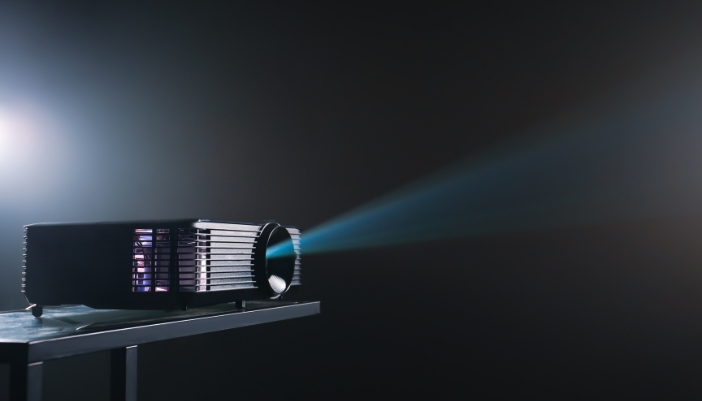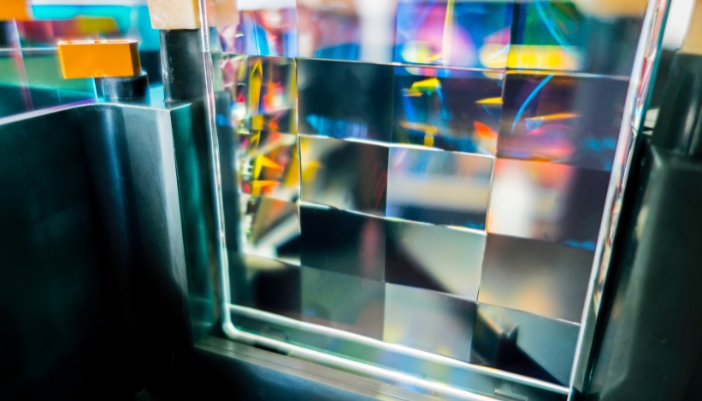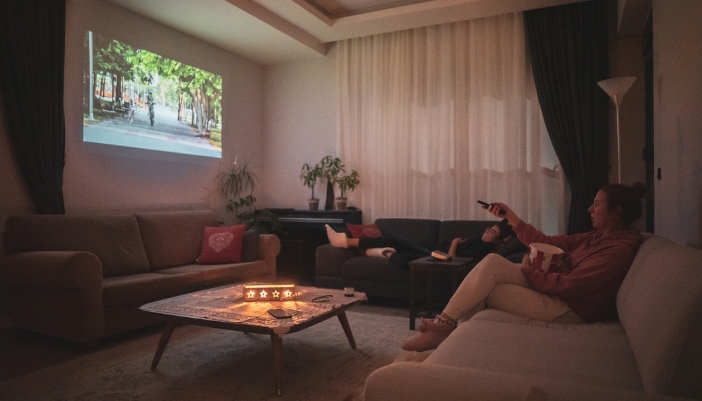Projectors are quickly becoming the centerpiece of home theaters, and for good reason — the advancements in projector technology! Before, projectors were reserved for boardrooms or classrooms with those individual slides (talk about a headache!), but now you can find them in any home theater!
With crisper images, more vibrant colors, and sizes (plus no more slides!), today’s projectors are more practical and fun for everyday use! But what goes into projection tech that makes it so appealing? And what’s the difference between the projector types?
These are all excellent questions, and luckily, we have the answers!
How Projectors Work

At their core, projectors are fascinating devices that bring images to life on the big screen. But how do they do it? It all starts with a simple concept: light. Regardless of its type, every projector uses a light source to project images onto a surface, typically a screen. However, it’s more involved than just that!
- Light Source: Traditional projectors use lamps, while newer models might use LEDs or lasers, but either way, the light source carries the image to the screen.
- Image Creation: To create an image, light passes through a small transparent lens with the image. In digital projectors, they use millions of tiny mirrors or liquid crystals that manipulate the light to form the picture.
- Projection Lens: Once the image is formed, it’s thrown onto the screen by the projection lens. This lens can often be adjusted to change the size of the image.
- Brightness and Contrast: The essential features for any projector is how much brightness and contrast it has. The light source determines brightness, while contrast is controlled by how well the projector can differentiate between light and dark areas of the image.
- Color: Projectors reproduce color by splitting the light into red, green, and blue using various methods, depending on the type of projector. These colors are then combined on the screen to create the full spectrum of colors.
Diving into DLP (Digital Light Processing)

DLP, or Digital Light Processing, is a popular type of projector technology known for its sharp images and reliability. At the heart of it is a chip known as the Digital Micromirror Device (DMD), packed with thousands of tiny mirrors, each representing a single pixel. These mirrors tilt rapidly to direct light through the lens to form a sharp and detailed image with quick response time and reduced motion blur in fast-paced scenes (great for sports or action-packed movies)!
However, there are some setbacks to DLP projectors, like the “rainbow effect,” a brief flash of rainbow-like colors that happens when the color wheel doesn’t sync up perfectly with the viewer’s eyes. The DLP also has difficulty varying deep black levels, so seeing darker images clearly can be troublesome.
Note:
DLDP projectors are more compact, durable, and require less maintenance!
Understanding LCD Projectors: Vivid Colors, Bright Scenes
LCD projectors are like the high-definition TVs of the projector world. They use a similar technology, where a light shines through three liquid crystal panels – one each for red, green, and blue colors. These panels mix the light to produce vibrant, true-to-life images from the real colors of a sunset to the deep blue of the ocean. But, along with their pros, they also have some cons:
- Pros: LCD projectors provide vivid colors ideal for animated movies or nature documentaries and have a bright output, so they don’t need absolute darkness to work.
- Cons: Unfortunately, the LCD tech will sometimes show a faint grid on the screen, especially if you’re up close (those are the pixels). These projectors can struggle with very dark scenes, making some details hard to make out.
Exploring LCoS Projectors: Where Precision Meets Elegance

LCoS, or Liquid Crystal on Silicon, represents a sweet spot in projector technology, merging the clarity of DLP with the smoothness of LCD. It works by reflecting off silicon-backed liquid crystal panels (instead of passing through them), combining the sharpness and fluid imagery of DLP and LCD. The results are an enviable clear image where you can see every detail, from the intricate patterns of a butterfly’s wing to the subtle play of light in a forest!
- Pros: LCoS projectors deliver images that are superior in sharpness and detail, without the “screen door effect” seen in LCDs, and feature more natural and true-to-life colors. It’s great for animated features or visually stunning sci-fi epics!
- Cons: The drawbacks of LCoS are that it comes with a higher price tag and is more finicky with brightness — they need a space where you can control ambient light like a dedicated home theater room!
Matching Projectors to Your Space

Choosing the right projector isn't just about the technology but also how it fits into your space. Room size and ambient light play pivotal roles in determining the best projector for your home cinema.
- Room Size Matters: For compact spaces, a short-throw DLP projector is ideal, but if you have the luxury of choice, an LCoS projector can truly shine.
- Ambient Light and Projector Brightness: LCD projectors, with their higher brightness and color accuracy, are well-suited for rooms with more ambient light, while LCoS, with their rich images, do well in darker rooms (or ones that control the brightness!).
- Adjustable Settings: Features like lens shift and zoom, found in many LCoS and some high-end DLP models, offer flexibility in projector placement and image adjustment, which is crucial for fitting the projector to your specific room dimensions.
Bonus: How Screen Types Impact Your Viewing Experience
The screen you pair with your projector is just as crucial as the projector itself. Different screen types can significantly enhance your projector's performance, affecting color accuracy and image clarity.
- White Screens provide a neutral surface that preserves the color and brightness of the projected image, making them suitable for a wide range of projectors, including LCoS and LCD (ideal for rooms with controlled lighting!).
- Gray Screens improve the perceived contrast of the image, making blacks appear deeper and truer to life, which is ideal for darker or HD, fast-paced content. These work best in rooms with ambient light or projectors with high contrast ratios (like DLP!).
- High-Gain Screens are designed to reflect more light directly back to the viewer, enhancing brightness, but they can sometimes narrow the viewing angle or exhibit hot-spotting. These work well with lower-lumen projectors in rooms with some ambient light.
- Acoustically Transparent Screens allow sound to pass through the screen without compromising audio quality (ideal for audiophiles who place the speakers behind the screen!). They're perfect for creating a truly immersive home theater experience.
- Motorized Screens retract when not, which offers flexibility and ensures that your living space doesn't always have to function as a cinema (or full of tech!).
Cinema Magic at Your Fingertips

Whether you prefer the vivid colors of an LCD, the sharpness of a DLP, or the richness of an LCoS, you’re bound to find cinema magic in your home theater! So, why wait to experience the joy yourself? Exactly! Take the opportunity to find your home theater projector upgrade at Plaza Electronics & Appliances! We have all the latest brands with the tech that’ll redefine how you watch TV!
Not sure which one is right for you? Our experts will happily fill you in with more details — just call or drop by!